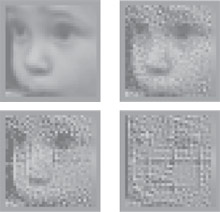Now I See You
Scientists have built a new type of prosthetic retina that could someday restore detailed sight to the millions of people who’ve lost their vision to retinal disease.

Neuroscientist Sheila Nirenberg, of Weill Cornell Medical College in New York, and postdoctoral student Chethan Pandarinath have enabled blind mice to see nearly normal images of everything from human and animal faces to complex panoramas of Central Park.
Artificial retinas already exist. But they require surgery to implant an array of electrodes deep into the eye. The electrodes stimulate cells that transmit information to the brain, and must be powered by an external battery. They are capable of restoring crude vision, allowing patients to pick up only major contrasts and edges, such as a light object against a dark background. But Nirenberg’s research, which was presented this week at the Society for Neuroscience meeting in San Diego, enables still and moving images to be conveyed more cleanly and rapidly than ever before possible. And the method doesn’t require surgery.
In mammals’ eyes, a set of cells in the retina detects light, and then a separate layer of cells, called ganglion cells, relays that information to the brain. Because macular degeneration and other retinal diseases cause the light-detecting cells to die but leave the ganglion cells intact, researchers have been trying for 50 years to decipher their code—the patterns by which the ganglion cells fire—so as to capitalize on the eye’s natural circuitry. Nirenberg has now nailed that, or at least a close approximation. After 10 years of work, she knows the relationship between what we see and how that translates into ganglion-cell firing patterns.
“It really is a triumph for our field,” says Jonathan Victor, a neuroscientist at Weill Cornell Medical College who was not involved in the research. “In retrospect, it might seem that it was obvious that you need to not just send signals to the brain (as current artificial retinas do) but also figure out how the retina transforms light into the particular signals that it sends. But somehow, nobody ever thought of it that way.”
After deciphering the retina’s code, Nirenberg wanted to deliver it to the brain in a way that was more precise than was possible using existing electrode technology. For this, she and her colleagues turned to optogenetics, a recently developed technique that infuses neurons with light-sensitive proteins from blue-green algae, causing them to fire when exposed to light.
The researchers used mice that were genetically engineered to express one of these proteins, channelrhodopsin, in their ganglion cells. Then, they presented the mice with an image that had been translated into a grid of 6,000 pulsing lights. Each light communicated with a single ganglion cell, and each pulse of light caused its corresponding cell to fire, thus transmitting the encoded image along to the brain. “Right now, you can’t get individual cells to fire using electrodes. With channelrhodopsin, you can target individual ganglion cells,” Nirenberg says.
In humans, such a setup would require a pair of high-tech spectacles, embedded in which would be a tiny camera, an encoder chip to translate images from the camera into the retinal code, and a miniature array of thousands of lights. When each light pulsed, it would trigger a channelrhodopsin-laden ganglion cell. Surgery would no longer be required to implant an electron array deep into the eye, although some form of gene therapy would be required in order for patients to express channelrhodopsin in their retinas. Nirenberg and Pandarinath have begun collaborating with a specialist in retinal gene therapy, University of Florida ophthalmologist William Hauswirth.
“It’s a pretty novel strategy. I haven’t seen anything out there like that yet,” says Ed Boyden, a bioengineer at MIT and one of the originators of optogenetics. “The data looks as if they could do certain things that could be quite powerful, stimulating the retina in a way that can cause neurons to more accurately simulate normal vision.”
In the meantime, the deciphered retinal code can also be applied to implants already on the market. Nirenberg is in talks with retinal-prosthesis maker Second Sight, in Sylmar, California, which has implanted electrode array devices in a number of patients. “We would just take their software out and put our software in,” Nirenberg says. “It’s going to take some time to do the gene therapy version, so let’s at least do something with the patients who already have the electrodes implanted.”
Keep Reading
Most Popular
Large language models can do jaw-dropping things. But nobody knows exactly why.
And that's a problem. Figuring it out is one of the biggest scientific puzzles of our time and a crucial step towards controlling more powerful future models.
The problem with plug-in hybrids? Their drivers.
Plug-in hybrids are often sold as a transition to EVs, but new data from Europe shows we’re still underestimating the emissions they produce.
Google DeepMind’s new generative model makes Super Mario–like games from scratch
Genie learns how to control games by watching hours and hours of video. It could help train next-gen robots too.
How scientists traced a mysterious covid case back to six toilets
When wastewater surveillance turns into a hunt for a single infected individual, the ethics get tricky.
Stay connected
Get the latest updates from
MIT Technology Review
Discover special offers, top stories, upcoming events, and more.